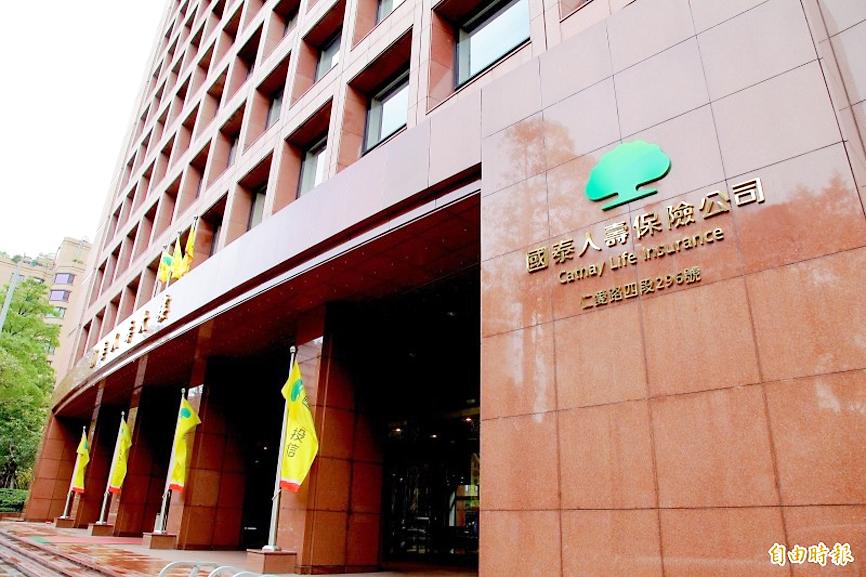Cathay Life Insurance Co (國泰人壽) yesterday reported a recurring yield of 3.29 percent as of the end of September, down from 3.8 percent a year earlier, as it takes a more cautious investment strategy amid the COVID-19 pandemic.
Recurring yield is a financial measure that shows how much a company earns from its investment on a regular basis.
Cathay Life registered recurring yields from a range between 3.47 and 3.8 percent during the January-to-September period over the past four years, company data showed.

Photo: Allen Wu, Taipei Times
Cathay Life was more proactive in taking advantage of the market volatility to sell stocks and secure capital gains than it was in the past few years, as it predicted that companies would distribute less cash dividends amid the pandemic, executive vice president Lin Chao-ting (林昭廷) told an investors’ conference in Taipei.
“We did not want to hold stocks just to get the dividends while losing the opportunity to earn the spread,” Lin said.
As the life insurer sold more stocks, it earned cash dividends of NT$16.2 billion (US$562.30 million) as of the end of September, down 34 percent from a year earlier, which trimmed its recurring yield by 16 basis points, he said.
Cathay Life preferred investment targets with higher credit ratings to avoid risks and disposed of those with ratings lower than triple B, which also reduced its recurring yield by 6 basis points, Lin said.
“Now we concentrate on those with ratings of triple B and A, while those with ratings of double B or lower only made up 1.6 percent of our investment portfolio, from 4.2 percent a year earlier,” Lin said.
A lower interest rate environment was also responsible for the drop in its recurring yield, he said.
Despite the lower recurring yield, Cathay Life booked capital gains of NT$112.7 billion for the first nine months of this year, which hit a record high and boosted the insurer’s cumulative net profit to a new high of NT$44.8 billion over the period.
Cathay Life said it would decide whether to raise its stake in Indonesia’s Bank Mayapada Internasional Tbk PT from 37.33 percent to 51 percent by the end of this year, after it in August booked an investment loss of NT$8.8 billion due to concerns about the lender’s operations amid a corporate scandal.

Shares in Taiwan closed at a new high yesterday, the first trading day of the new year, as contract chipmaker Taiwan Semiconductor Manufacturing Co (TSMC, 台積電) continued to break records amid an artificial intelligence (AI) boom, dealers said. The TAIEX closed up 386.21 points, or 1.33 percent, at 29,349.81, with turnover totaling NT$648.844 billion (US$20.65 billion). “Judging from a stronger Taiwan dollar against the US dollar, I think foreign institutional investors returned from the holidays and brought funds into the local market,” Concord Securities Co (康和證券) analyst Kerry Huang (黃志祺) said. “Foreign investors just rebuilt their positions with TSMC as their top target,

REVENUE PERFORMANCE: Cloud and network products, and electronic components saw strong increases, while smart consumer electronics and computing products fell Hon Hai Precision Industry Co (鴻海精密) yesterday posted 26.51 percent quarterly growth in revenue for last quarter to NT$2.6 trillion (US$82.44 billion), the strongest on record for the period and above expectations, but the company forecast a slight revenue dip this quarter due to seasonal factors. On an annual basis, revenue last quarter grew 22.07 percent, the company said. Analysts on average estimated about NT$2.4 trillion increase. Hon Hai, which assembles servers for Nvidia Corp and iPhones for Apple Inc, is expanding its capacity in the US, adding artificial intelligence (AI) server production in Wisconsin and Texas, where it operates established campuses. This

H200 CHIPS: A source said that Nvidia has asked the Taiwanese company to begin production of additional chips and work is expected to start in the second quarter Nvidia Corp is scrambling to meet demand for its H200 artificial intelligence (AI) chips from Chinese technology companies and has approached contract manufacturer Taiwan Semiconductor Manufacturing Co (TSMC, 台積電) to ramp up production, sources said. Chinese technology companies have placed orders for more than 2 million H200 chips for this year, while Nvidia holds just 700,000 units in stock, two of the people said. The exact additional volume Nvidia intends to order from TSMC remains unclear, they said. A third source said that Nvidia has asked TSMC to begin production of the additional chips and work is expected to start in the second

Garment maker Makalot Industrial Co (聚陽) yesterday reported lower-than-expected fourth-quarter revenue of NT$7.93 billion (US$251.44 million), down 9.48 percent from NT$8.76 billion a year earlier. On a quarterly basis, revenue fell 10.83 percent from NT$8.89 billion, company data showed. The figure was also lower than market expectations of NT$8.05 billion, according to data compiled by Yuanta Securities Investment and Consulting Co (元大投顧), which had projected NT$8.22 billion. Makalot’s revenue this quarter would likely increase by a mid-teens percentage as the industry is entering its high season, Yuanta said. Overall, Makalot’s revenue last year totaled NT$34.43 billion, down 3.08 percent from its record NT$35.52